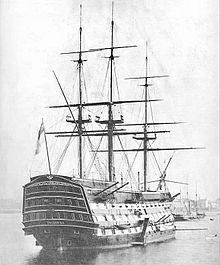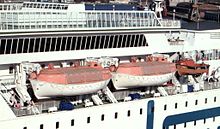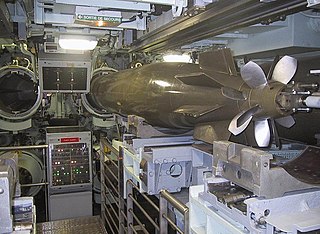
A torpedo tube is a cylindrical device for launching torpedoes.

A winch is a mechanical device that is used to pull in or let out or otherwise adjust the tension of a rope or wire rope.
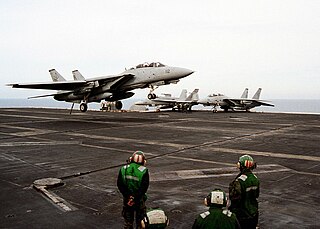
An arresting gear, or arrestor gear, is a mechanical system used to rapidly decelerate an aircraft as it lands. Arresting gear on aircraft carriers is an essential component of naval aviation, and it is most commonly used on CATOBAR and STOBAR aircraft carriers. Similar systems are also found at land-based airfields for expeditionary or emergency use. Typical systems consist of several steel wire ropes laid across the aircraft landing area, designed to be caught by an aircraft's tailhook. During a normal arrestment, the tailhook engages the wire and the aircraft's kinetic energy is transferred to hydraulic damping systems attached below the carrier deck. There are other related systems that use nets to catch aircraft wings or landing gear. These barricade and barrier systems are only used for emergency arrestments for aircraft without operable tailhooks.

The deck department is an organisational team on board naval and merchant ships. The department and its manning requirements, including the responsibilities of each rank are regulated within the STCW Convention, applicable only to the merchant fleets of countries who have ratified it. The department is led by deck officers, who are licensed mariners, and they are commanded overall by the ship's captain. Seafarers in the deck department work a variety of jobs on a ship or vessel, but primarily they will carry out the navigation of a vessel from the bridge. However, they are usually also responsible for supervising and monitoring any maritime cargo on board, as well as ensuring maintenance of the deck and upper hull structure, monitoring the stability of the ship, including loading and discharging ballast water, carrying out mooring operations, and finally anchoring a ship.
A ship's hold or cargo hold is a space for carrying cargo in the ship's compartment.

A windlass is a machine used on ships that is used to let-out and heave-up equipment such as a ship's anchor or a fishing trawl. On some ships, it may be located in a specific room called the windlass room.

A linkspan or link-span is a type of drawbridge used mainly in the operation of moving vehicles on and off a roll-on/roll-off (RO-RO) vessel or ferry, particularly to allow for tidal changes in water level.

A fishing vessel is a boat or ship used to catch fish and other valuable nektonic aquatic animals in the sea, lake or river. Humans have used different kinds of surface vessels in commercial, artisanal and recreational fishing.

An able seaman (AB) is a seaman and member of the deck department of a merchant ship with more than two years' experience at sea and considered "well acquainted with his duty". An AB may work as a watchstander, a day worker, or a combination of these roles. Once a sufficient amount of sea time is acquired, then the AB can apply to take a series of courses/examinations to become certified as an officer.

A marine evacuation system (MES) is a lifesaving device found on many modern passenger ships or oil rigs consisting of an inflatable slide or escape chute where a passenger can evacuate straight into waiting life rafts. Developed in 1979 by RFD, a New Zealand–based company that distributes safety equipment; MES is replacing traditional davit-launched life rafts used on ships.

A lifeboat or liferaft is a small, rigid or inflatable boat carried for emergency evacuation in the event of a disaster aboard a ship. Lifeboat drills are required by law on larger commercial ships. Rafts (liferafts) are also used. In the military, a lifeboat may double as a whaleboat, dinghy, or gig. The ship's tenders of cruise ships often double as lifeboats. Recreational sailors usually carry inflatable liferafts, though a few prefer small proactive lifeboats that are harder to sink and can be sailed to safety.
TEMPSC is an acronym for "Totally Enclosed Motor Propelled Survival Craft", which was originally designed for offshore oil and gas platforms in 1968. The first-ever TEMPSC was spherical in shape, had a flat bottom, a single hook, with a total passenger capacity of 28 passengers and a fire-retardant fibreglass hull and dome. It was manufactured in Beverly Hills, California, by the Brucker Life Sphere Company, owned by its creator, Mr. Milton Brucker. The first TEMPSC was called the Brucker Life Sphere, but was later referenced as a "Totally Enclosed, Motor Propelled Survival Capsule".
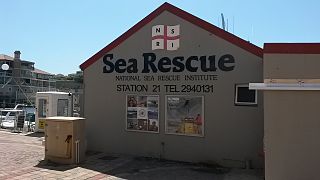
The National Sea Rescue Institute (NSRI) is a voluntary non-profit organisation in South Africa tasked with saving lives through drowning prevention. It operates 49 bases comprising coastal stations, inland stations on dams, auxiliary stations and lifeguard units. There are crews on standby at all hours. There are over 1000 volunteers equipped with sponsored rescue craft, rescue vehicles, quad bikes and tractors, supported by an operations department at the head office.

TSS (RMS) Mona's Queen (III) No. 145308, was a ship built for the Isle of Man Steam Packet Company in 1934. The steamer, which was the third vessel in the company's history to bear the name, was one of five ships to be specially commissioned by the company between 1927 and 1937. They were replacements for the various second-hand steamers that had been purchased to replace the company's losses during the First World War. However, the life of the Mona's Queen proved to be short: six years after being launched she was sunk by a sea mine during the Dunkirk evacuation on 29 May 1940.

MS American Leader was a merchant cargo ship which entered service for the United States Lines in 1941. It was most noted for falling victim to the German auxiliary cruiser Michel during the Second World War. Her surviving crew members were taken as prisoners of war and collectively they endured three ship sinkings.

SS Empress Queen was a steel-hulled paddle steamer, the last of her type ordered by the Isle of Man Steam Packet Company. The Admiralty chartered her in 1915 as a troop ship a role in which she saw service until she ran aground off Bembridge, Isle of Wight, England in 1916 and was subsequently abandoned.

Lifeboats played a crucial role during the sinking of the Titanic on 14–15 April 1912. The ship had 20 lifeboats that, in total, could accommodate 1,178 people, a little over half of the 2,209 on board the night it sank.
Vadyar Boats Pvt. Ltd. is a Chennai based boat manufacturer and marine service provider.
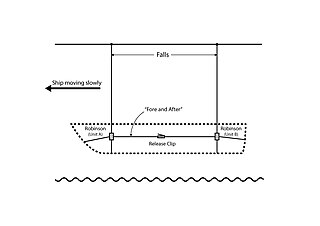
The Robinson's Disengaging Gear is a system for safely releasing a small seaboat into the sea from a larger ship. The Robinson's Disengaging Gear has been standard equipment on British Royal Navy ships since 1880. The term seaboat is used here to describe a work boat that is used in everyday ship operations for transferring people, inspecting other vessels, etc. A seaboat is different from a lifeboat, which is only used in an emergency to save lives. Historically, a sea boat was also used as a lifeboat, but today (2014) lifeboats are usually specialized boats, not used for everyday work.
ISO 7010 is an International Organization for Standardization technical standard for graphical hazard symbols on hazard and safety signs, including those indicating emergency exits. It uses colours and principles set out in ISO 3864 for these symbols, and is intended to provide "safety information that relies as little as possible on the use of words to achieve understanding."

